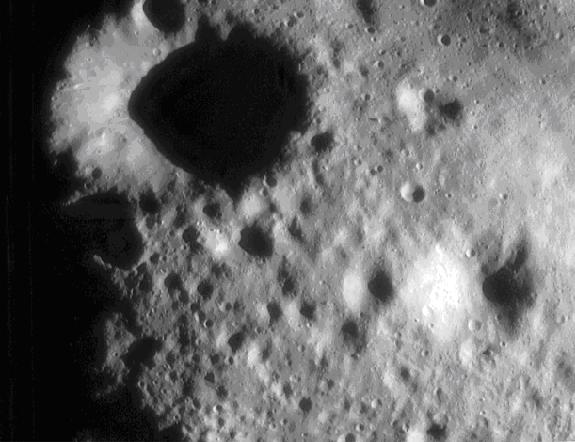
home •
about •
essential guide •
picture of the day •
thunderblogs •
news •
multimedia •
predictions •
products •
get involved •
contact
picture of the day archive subject index
Credit: NASA/NEAR Shoemaker
Dec 28, 2006
Craters on ErosThe NEAR-Shoemaker probe of the asteroid Eros revealed a non-random cratering pattern that continues to baffle astronomers.
Craters on asteroid Eros were expected to show a typical random distribution. There should be a few large craters, more medium-sized craters and many more small craters, because impacts of smaller objects should happen more often than impacts of large objects.
But when NEAR-Shoemaker passed close to Eros in 2000-2001, researchers discovered that the craters don't follow the expected distribution curve. The few large craters and the many medium-sized craters appear as expected, but craters smaller than 100m in diameter are rare. This is a problem for the impact-model: how can most of the small rocks in space have consistently missed the asteroid for billions of years?
A lower limit to the size of craters is an expected feature from an Electric Universe point of view. The size of craters is related to the strength of the arc discharge that carves them. Below a specific threshold, the arc cannot be maintained. It quenches, so smaller craters are not produced.
Arc discharges, and the conditions which ignite and quench them, will vary with the size, composition, charge, and other factors unique to each individual world. The number of times a surface is electrically etched can vary, too. Comets experience arcing every time they pass through the inner solar system. Asteroids may have received most of their craters during the event in which they were born. A single episode of arcing would leave craters characteristic of the conditions prevailing at that one time. The record may or may not be "overwritten" depending on whether further arcing episodes occur under different conditions.
___________________________________________________________________________Please visit our Forum
The Electric Sky and The Electric Universe available now!

|
|

|
EXECUTIVE EDITORS:
David Talbott, Wallace Thornhill
MANAGING EDITORS:
Steve Smith, Mel Acheson
CONTRIBUTING EDITORS: Dwardu Cardona, Ev Cochrane,
C.J. Ransom, Don Scott, Rens van der Sluijs, Ian Tresman
WEBMASTER: Brian Talbott
Copyright 2006: thunderbolts.info
![]()
home •
thunderblogs •
forum •
picture of the day •
resources •
team •
updates •
contact us

